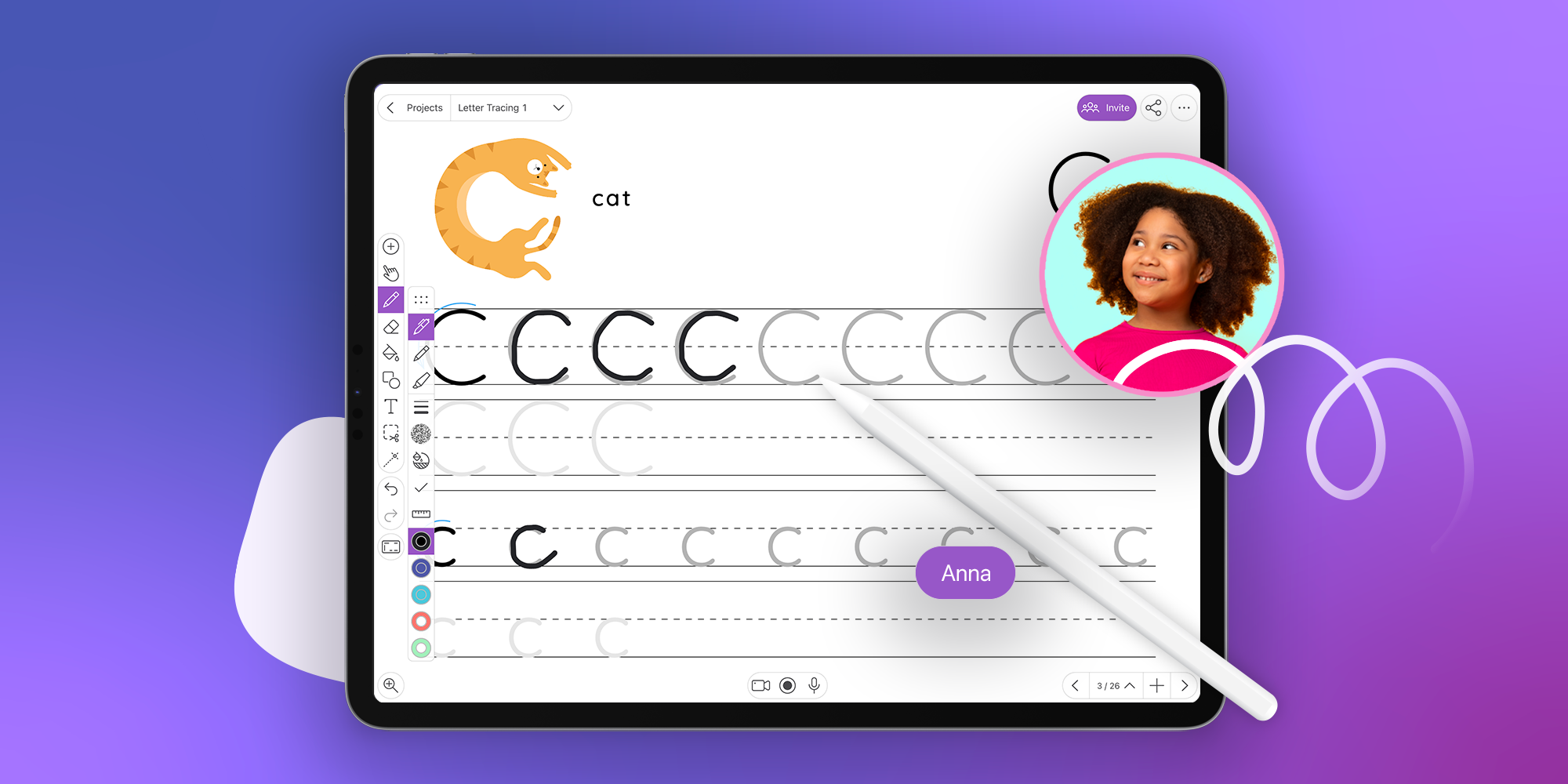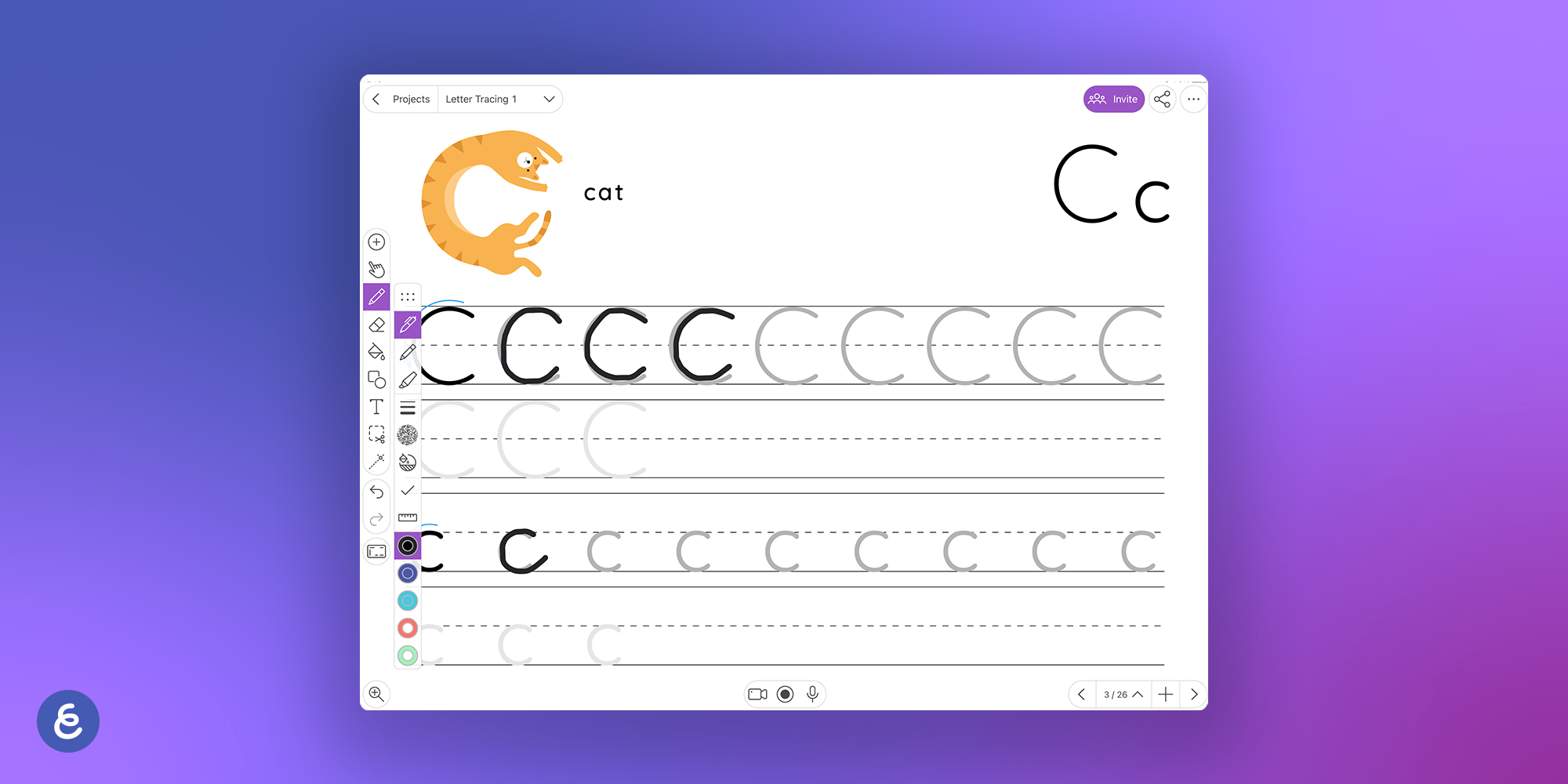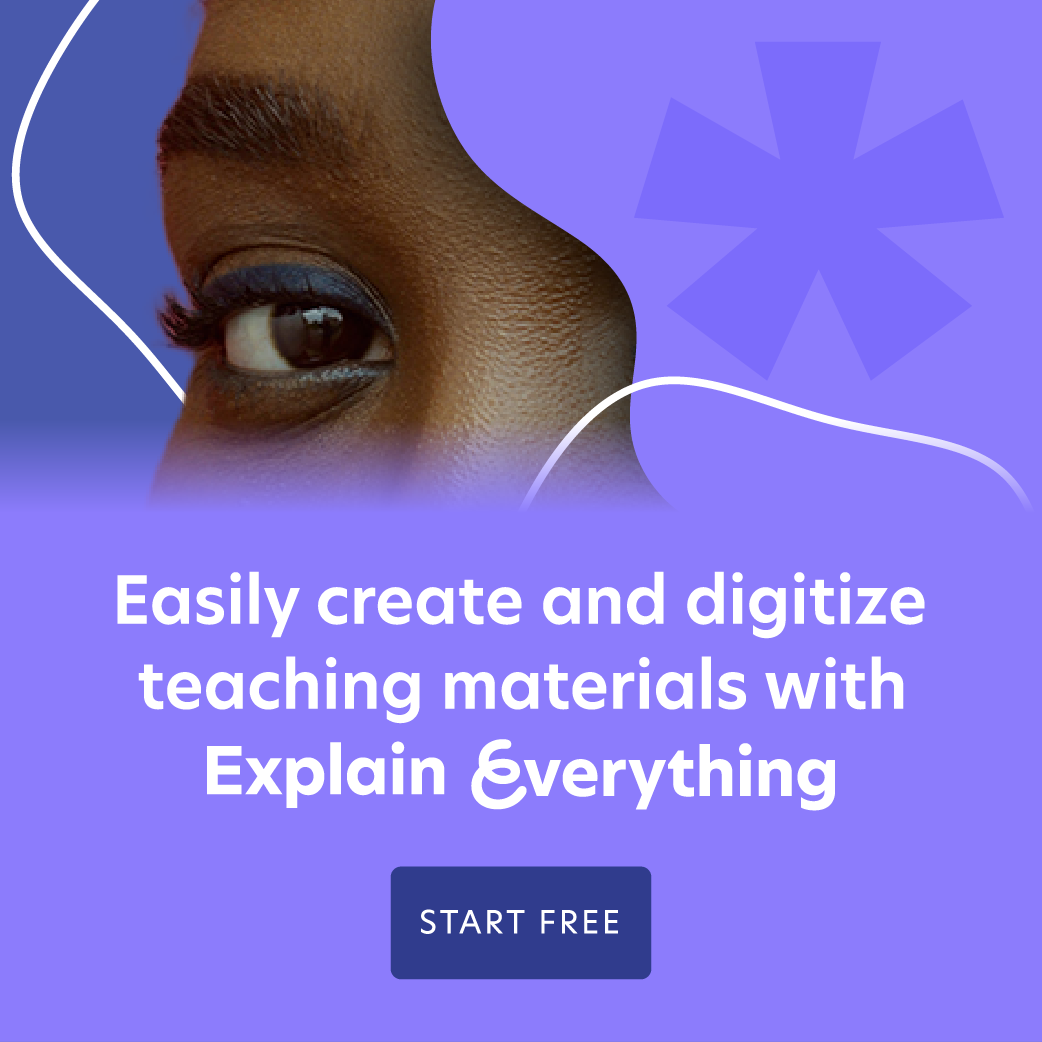How Explain Everything helps you teach phonics to beginner readers

Table of Contents
How to teach phonics
Phonics is a popular way of teaching introductory reading and writing skills. It involves educating beginning readers about how individual letters and certain groups of letters sound in the English language. In many schools, phonics is key to teaching children how to read.
Phonics can be considered a code – with the squiggles and lines that make up letters representing a sound. And teaching phonics is key to helping learners crack it.
How to teach phonics step by step
The best way to teach phonics involves breaking things down systematically. A popular phonics methodology that takes things step by step is called Letters and Sounds. This was developed by the United Kingdom’s Department of Education in 2007 but serves as a good basis for teaching English phonics anywhere.
The six phases of Letters and Sounds phonics teaching are as follows:
Phase 1
Phase 1 lays the foundation for using phonics for reading.
This first phase involves encouraging young children to become more aware of sounds. This content is appropriate from preschool onwards. Phonics lessons for kindergarten should begin here, even if some children have already been exposed to this understanding from parents or preschool educators.
Phase 1 focuses on:
- Environmental sounds – the noises we hear around us, such as the ‘vroom’ of a car
- Instrumental sounds – anything created by an instrument, like the ‘bang’ of a drum
- Body percussion – the sounds we can make with our bodies, e.g., clapping, stomping, patting, etc.
- Rhythm and rhyme – this is about picking up the rhythm in words and identifying rhyming patterns, such as ‘dog’ and ‘frog’
- Alliteration – phonetic alliteration means two or more consecutive words beginning with the same sound, e.g., ‘bouncing bunny’; this is not about words that start with the same letter but sound different, e.g., ‘kind knight’)
- Voice sounds – these are the voices we can make that aren’t typical words, such as ‘woo’ when cheering.
- Oral blending and segmenting – segmenting is the ability to break down a word into its constituent sounds (known as phonemes), such as ‘c’-‘a’-‘t’, while oral blending is when you bring them together when you speak to make a word, like ‘cat’
Teachers can use Explain Everything’s online whiteboard to create relevant, multimedia learning resources. For example, teachers can upload images, audio, and video files of objects and instruments via Explain Everything and share these with their classes via a connected device. By doing this, children can hear phonetic sounds alongside visual representations which can help them remember what they’ve learned.
If using Explain Everything on an interactive display, such as a Promethean ActivPanel 9, teachers can take this a step further. On displays like this, children can use their fingers or whiteboard pens to write out the related phonetic sounds. Once pupils become more familiar with these sounds, teachers can utilize the drag-and-drop features of an interactive display to encourage class participation. For an engaging activity, teachers can upload images of objects and their corresponding phonemes and ask their pupils to match the sounds to the pictures.
Phase 2
Phase 2 focuses heavily on phonemes and helps children learn the most common ones.
Following the Letters and Sounds framework, educators will teach 23 phonic sounds of letters by breaking this down into five distinct sets. This helps pace the learning and enables teachers to identify when their pupils are ready to move on.
Knowing the below groups is key for how to teach letter sounds:
- Set 1 – s, a, t, p
- Set 2 – i, n, m, d
- Set 3 – g, o, c, k
- Set 4 – ck, e, u, r
- Set 5 – h, b, f, ff, l, ll, ss
At the same time as teaching these sounds, teachers should also support children to learn how to spell words. This should start with the most straightforward words, described as VC (vowel-consonant), i.e. two letter words like ‘no’ and ‘be’, and CVC (consonant-vowel-consonant), i.e. three letter words like ‘bit’ and ‘hug’. Although only learning small words at this stage, there will still be some tricky words. For example, ‘no’ and ‘go’ do not rhyme with ‘do’. Because of this, children need to learn some words by recognition.
Teachers can use Explain Everything to create sound mats. These are visual learning devices that show each grapheme (the letter or letters that represent how we write a phoneme) with a corresponding image. For Phase 2 phonics, teachers can create a sound mat for each set (e.g., Set 1 – s, a, t, p) and use Explain Everything’s built-in Clipart Library to quickly add in relevant images (e.g., snake, apple, tea, pan).
Phase 3
Phase 3 explores less common phonemes and the sounds of letters not covered in Phase 2.
The new Phase, 3 phonics sounds, are:
- j
- v
- w
- x
- y
- z (and zz)
- qu
- ch
- sh
- th
- ng
- ai
- ee
- igh
- oa
- ar
- or
- ur
- ow
- oi
- ear
- air
- ure
- er
Teachers should introduce these individually because these are more difficult than those introduced in Phase 2. By gradually incorporating these phonemes into reading lessons, teachers give their pupils time to familiarize themselves with the harder material.
By the end of Phase 3, children should be able to recite the alphabet and identify all 26 letters.
Once again, teachers may choose to use Explain Everything to create a sound mat. In addition to Clipart resources, Explain Everything Advanced has integrations with Unsplash and GIPHY. Teachers can create more variety in their sound mats by sourcing photographs from Unsplash or GIFs from GIPHY.
As Phase 3 also focuses on learning all the letters of the alphabet, teachers could also create an alphabet mat. An alphabet mat is like a sound mat but lists the letters of the alphabet rather than a collection of phonemes.
Phase 4
Phase 4 is about learning to use phonemes.
Part of this involves educators teaching their pupils how to recognize consonant clusters (which are sets of adjacent consonants). At this stage, children should be able to write and say words without having to sound out each phoneme. It’s here where children begin to understand ‘cat’ as ‘cat’ rather than ‘c-a-t’ for example.
This phase is also when teachers introduce more tricky words that do not fit phoneme patterns. The Letters and Sounds teaching list consists of:
- come
- do
- have
- like
- little
- one
- out
- said
- so
- some
- there
- were
- what
- when
For this phase, teachers can continue to use Explain Everything to create sound mats. However, as students progress throughout their phonics lessons, they may want their teachers to challenge them more. Creating interactive activities can keep pupils engaged and encourage independent learning. One way of doing this is to insert Clipart and have a related word partially spelled out below, e.g. a picture of a hand and then ‘h _ _ _’. The teacher can then ask students to fill in the gaps.
Phase 5
For Phase 5, educators should return to teaching new phonemes and graphemes.
As children are becoming more confident at this stage, it’s time for teachers to introduce alternate spellings and vowel combinations. These phonemes sound different to what children may expect, based on some of the ‘rules’ they’ve learned earlier.
The Phase 5 phonics sounds are:
- ay (as in playground)
- ou (as in cloud)
- ew (as in threw)
- ie (as in pie)
- ea (as in bean)
- oy (as in toys)
- ir (as in girl)
- ue (as in glue)
- aw (as in claw)
- wh (as in wheel)
- ph (as in dolphin)
- oe (as in toe)
- au (as in sauce)
- a-e (as in cake)
- e-e (as in eve)
- i-e (as in slide)
- u-e (as in flute)
Teachers can use Explain Everything to create another sound mat for the new phonemes. They can also use Explain Everything to create picture activities. By using Clipart or uploading images, teachers can create a scene that shows pictures relating to newly learned words (e.g., a girl with her toys in a playground next to a slide). Teachers can annotate these images with their relevant phonemes (e.g., ir, oy, ay, i-e) by using the writing and highlighting tools built into the Explain Everything toolbar. Teachers can then ask their pupils to identify the words.
Phase 6
At this point, children should have already learned most graphemes and phonemes. Children should now be able to sight-read a lot of words, including some tricky ones. They should also be confident enough in phonics skills (such as sounding out and blending) to attempt pronouncing new words.
The focus for teachers here is how to go from phonics to reading. Educators will now want to steer their lessons towards the acts of reading and spelling at a beginner’s level rather than the method of phonics. Children should now have the skills to start reading independently and gradually progress to higher-level reading activities.
At this stage, teachers may want to use Explain Everything to facilitate feedback. The 3-2-1 Reflection template invites students to think about three things they’ve learned, two questions they still have, and one thing they found particularly challenging. Teachers can adjust this template to ask their pupils different questions and focus on phonics. While children in their early years may struggle to fill this in independently, teachers can still use this template to encourage their pupils to reflect. By asking pupils to think about this and listening to their unique answers, teachers can address any common areas of concern. Educators can also use feedback to identify students who may need more support.
Explain Everything phonics templates
Explain Everything offers a variety of free ready-made templates to help teachers deliver interactive lessons.
Teachers can use these templates for all subjects, including phonics.
One Explain Everything template that teachers can use to teach phonics is:
Language arts – letter tracing template

A crucial part of understanding phonics is recognizing graphemes.
This letter tracing template helps young learners practice writing out different letters. This allows children to become familiar with the shapes of graphemes while improving their handwriting. The template includes a word example for each letter, reminding pupils of the related phoneme.
Students can use this interactive template on their devices, such as iPads or Chromebooks. This enables pupils to practice at their own pace.
View the Letter Tracing interactive template
Teaching phonics with Explain Everything
Explain Everything’s free online whiteboard software can help you create resources for teaching phonics, including sound and alphabet mats. Plus, you can encourage interactivity with tasks that your pupils can get involved with.
To begin your journey, sign up for your free Explain Everything account today. Ready for more? Upgrade to Explain Everything Advanced and benefit from unlimited projects and the latest features.
Recommended articles:
- Teaching Reading and Writing with a Smartboard
- Handwriting practice with a whiteboard app
- 15 Tips for First Year Teachers

